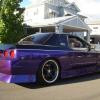Rb25 Vct Question, And Thermostat Question
Announcements
-
Similar Content
-
Latest Posts
-
With stone chips, you really can't just try to fill them. You really have to sand that spot to lower the edges of the chip, so that the filler will end up covering a wider patch than just the chip. Otherwise, you're trying to have a sharp edged paint surface match up to some filler, and they just do not sand the same and you always end up with a noticable transition. A bunch of adjacent chips should be well sanded back, to round off all those edges, and use a lot (in a relative sense) of filler to raise the whole area back.
-
By Dose Pipe Sutututu · Posted
Sunday car care, I take care of my cars. -
To expand on this to help understanding... The bigger/longer the block is, the more it's going to work to sit on your far away high areas, and not touch the low stuff in the middle. When you throw the guide coat, and give it a quick go with a big block, guide coat will disappear in the high spots. If those high spots are in the correct position where the panel should be, stop sanding, and fill the low spots. However, using a small block, you "fall off" one of the high spots, and now your sanding the "side of the hill". Your little block would have been great for the stone chips, where you only use a very small amount of filler, so you're sanding and area let's say the size of a 5/10cent piece, with something that is 75*150. For the big panel, go bigger! And now I'll go back to my "body work sucks, it takes too much patience, and I don't have it" PS, I thought your picture with coloured circles was an ultra sound... That's after my brain thought you were trying to make a dick and balls drawing...
-
By Murray_Calavera · Posted
Oh I probably didn't speak enough about the small sanding block for blocking large areas. In the video about 3 minutes in, he talks about creating valleys in the panel. This is the issue with using a small sanding block for a large area, it's way too easy to create the valleys he is talking about. With a large block its much easier to create a nice flat surface. Hard to explain but in practice you'll notice the difference straight away using the large block. -
By Murray_Calavera · Posted
Yep I guessed as much. You'll find life much easier with a large block something like this - https://wholesalepaint.com.au/products/dura-block-long-hook-loop-sanding-block-100-eva-rubber-af4437 This is a good demo video of something like this in use - You have turned your small rock chip holes into large low spots. You'll need to fill and block these low spots. It's always a little hard not seeing it in person, but yes I would go ahead and lay filler over the whole area. Have a good look at the video I linked, it's a very good example of all the things you're doing. They went to bare metal, they are using guide coat, they are doing a skim coat with the filler and blocking it back. If what you're doing doesn't look like what they are doing, that's a big hint for you
-





Recommended Posts
Create an account or sign in to comment
You need to be a member in order to leave a comment
Create an account
Sign up for a new account in our community. It's easy!
Register a new accountSign in
Already have an account? Sign in here.
Sign In Now